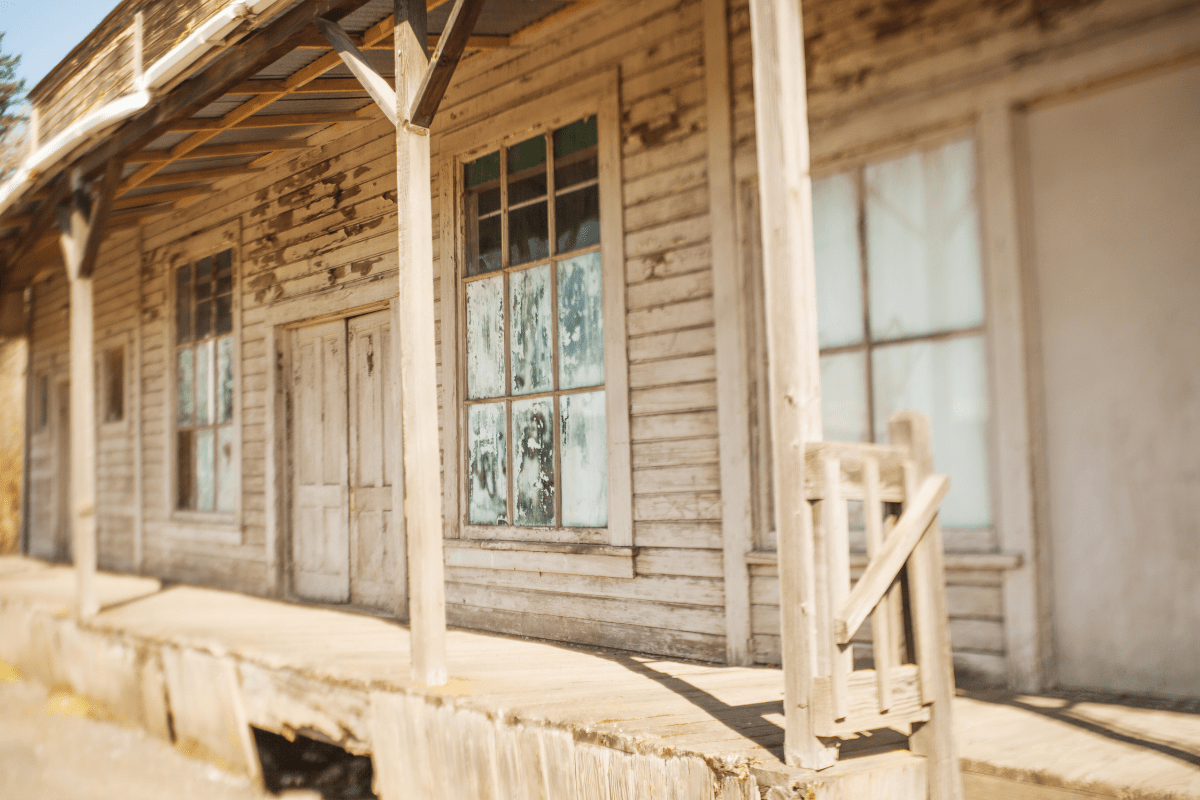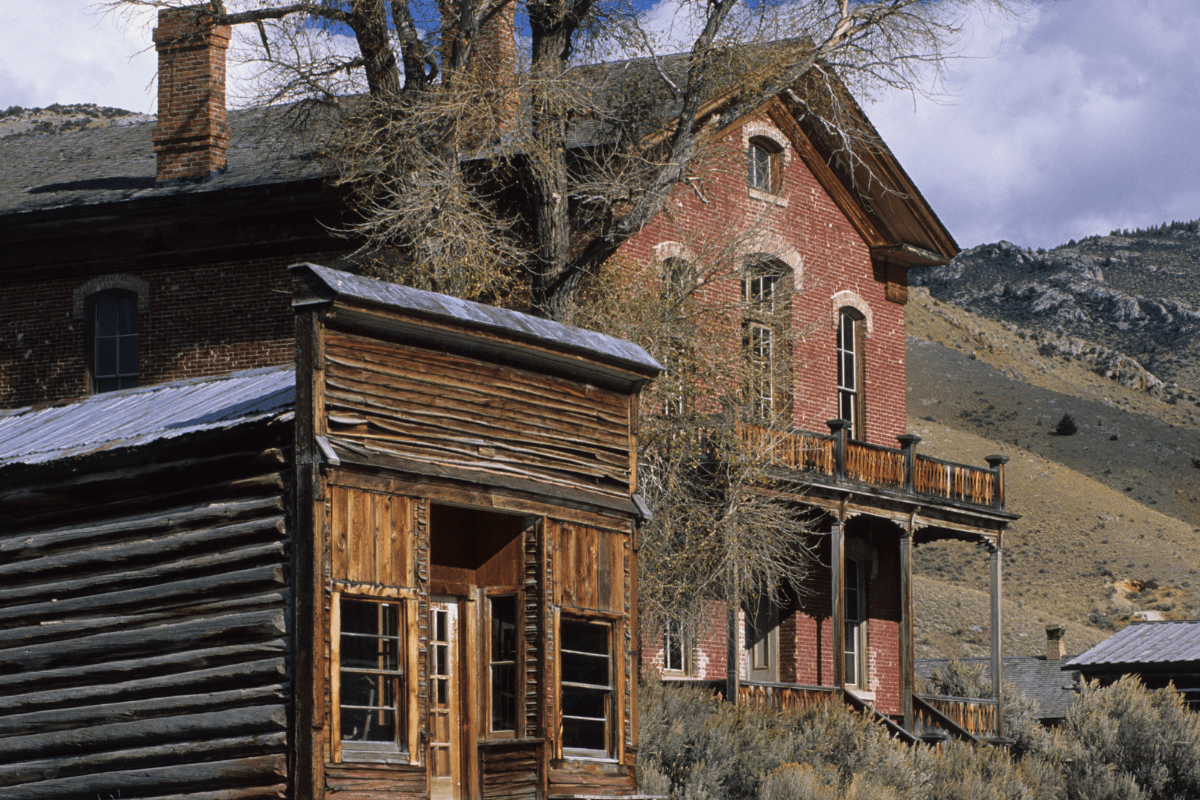Montana's ghost towns aren't your typical tourist traps with gift shops selling "I Survived the Wild West" t-shirts. These are actual abandoned mining settlements where dishes still sit on tables from hasty departures over a century ago, and winter caretakers casually mention the piano that plays itself at midnight.
Why Montana's ghost towns beat any history textbook
Let's be honest… nobody really remembers their high school history lessons about the American frontier. But stand inside Bannack's Hotel Meade, where vigilantes once plotted to hang their own sheriff, and suddenly the Wild West becomes viscerally real. These weathered buildings tell stories that Hollywood wishes it could script.
Montana transformed from empty wilderness to official U.S. territory in just two years, thanks to gold discoveries that would make today's crypto millionaires jealous. When John White struck gold at Grasshopper Creek in 1862, he triggered a rush that built entire cities in months. The following year, prospectors at Alder Gulch extracted over $100 million in gold, worth more than a billion in today's money. That's the kind of return on investment that explains why people hauled pianos over mountain passes to towns that might not exist next year.
The boom that built everything
These weren't just camps full of grizzled prospectors panning for gold. Families arrived with china sets, merchants opened shops, and communities built schools, churches, and opera houses. Garnet even designated a special cabin for newlyweds, rotating couples through until they could build their own homes. Try finding that kind of community support in today's housing market.
The bust came just as quickly. The 1893 Silver Panic turned Granite from a thriving city of 3,000 residents into a ghost town of 140 people literally overnight. Imagine your entire neighborhood packing up and leaving between breakfast and dinner. That's exactly what happened, repeatedly, across Montana's mining districts.
Eight ghost towns worth the questionable road conditions
Not all ghost towns are created equal, and some require significantly more commitment than others. Here's your hierarchy of abandonment, from "easy Sunday drive" to "did I just break an axle?"
Bannack State Park: Your gateway drug to ghost towns
If ghost towns were a college course, Bannack would be the 101 class everyone should take first. Located 25 miles southwest of Dillon, this former territorial capital preserves over 50 buildings in various states of photogenic decay. You can peer into Skinner's Saloon where Sheriff Henry Plummer supposedly planned robberies while wearing his badge, then climb the schoolhouse steps where frontier kids learned reading, writing, and probably how to spot claim jumpers.
The park charges $8 per vehicle for non-residents (free for Montana residents who already pay through taxes). Summer hours extend to 9pm, perfect for photographers chasing that golden hour light through broken windows. The third weekend in July brings Bannack Days, when costumed interpreters demonstrate blacksmithing, gold panning, and other skills that nobody needs anymore but everyone finds fascinating.
Best of all, you can actually camp here with 28 sites available. Nothing says "authentic Western experience" like waking up to tumbleweeds and the realization that your tent is probably pitched where someone died of dysentery.
Garnet Ghost Town: Where things get genuinely spooky
Thirty miles east of Missoula sits Montana's best-preserved ghost town, though "preserved" might be generous. The Bureau of Land Management maintains Garnet's 30 structures in what they call "arrested decay," which basically means they're falling apart really, really slowly.
At its 1898 peak, Garnet boasted 1,000 residents, 13 saloons, four hotels, and presumably a lot of hangovers. The J.K. Wells Hotel still contains period furnishings visible through windows, assuming you can ignore the reports of phantom footsteps on the upper floors. Kelly's Saloon generates the most paranormal activity, with multiple witnesses describing piano music and laughter on winter nights. The winter caretaker just shrugs when asked about it, which is either comforting or terrifying depending on your perspective.
Here's the fun part: you can rent heated cabins here in winter, but you'll need to arrive by snowmobile, cross-country skis, or snowshoes. Nothing says "romantic getaway" like being snowed in with ghosts and no cell service. Book months in advance if you're brave enough.
Virginia City and Nevada City: Ghost towns with a pulse
These towns refuse to die properly. Virginia City maintains 237 buildings with operating businesses and restaurants, while Nevada City functions as an outdoor museum with 90 relocated historic structures. A narrow-gauge railroad connects them, because apparently walking between ghost towns isn't atmospheric enough.
Virginia City feels less "abandoned mining camp" and more "Old West theme park that happens to be authentic." You can catch vaudeville shows at the Opera House, ride stagecoaches down Wallace Street, and buy candy from shops where miners once traded gold dust for beans. The towns fully operate from Memorial Day through Labor Day, with train tickets around $10 and various activity fees that would've bought a whole saloon in 1864.
Elkhorn State Park: Instagram's favorite ruins
Just two buildings remain standing in Elkhorn, but Fraternity Hall and Gillian Hall's Greek Revival architecture makes them Montana's most photographed ghost town structures. Located 18 miles northeast of Boulder via gravel roads, the park allows exterior viewing only, which is probably wise given their age.
The silver mining town peaked in the 1880s with 2,500 residents, mostly European immigrants who extracted $14 million from the Elkhorn Mine. The nearby cemetery tells darker stories, particularly the section dedicated to children who died in the 1888 diphtheria epidemic. About 10 people still live in the surrounding private town, presumably enjoying the peace and quiet.
The ones that make you earn it
Granite Ghost Town State Park sits 5 miles above Philipsburg and requires navigating what recent visitors describe as a "horrible" and "dangerous" road. Sharp rocks threaten tires, narrow passages test your spatial awareness, and steep grades make you question your life choices. Many turn back rather than risk vehicle damage, which might be the smartest decision they make all day.
Coolidge Ghost Town demands even more commitment with a one-mile hike from the parking area through the Pioneer Mountains. Built between 1918-1919 as Montana's last major mining venture, it included modern amenities like electricity and telephone service. A 1927 dam failure destroyed the railroad connection, dooming the enterprise. Today, the Tyro House stands as the only intact roofed structure, making it a long walk for limited payoff unless you really love ruins.
Planning your descent into abandonment
When to go (and when to absolutely not go)
The sweet spot runs from late May through September, when roads dry out and visitor centers actually have visitors to center. October brings variable weather that can trap you faster than a bad Tinder date. November through April limits access to basically Bannack and the living ghost towns, unless you're into winter sports and potential frostbite.
Here's your seasonal breakdown:
- Summer: Full access, full crowds, full heat
- Fall: Beautiful colors, sketchy weather, fewer tourists
- Winter: Limited access, maximum atmosphere, possible ghosts
- Spring: Mud season, aka "hope you brought a winch"
Getting there without destroying your vehicle
Road quality varies from "rental car friendly" to "hope you bought the insurance." Here's what you're dealing with:
Easy access (sedan-friendly):
- Bannack: Paved highway plus maintained gravel
- Virginia City: Paved state highways year-round
Moderate challenge (SUV recommended):
- Garnet: 11-mile dirt road, no RVs
- Elkhorn: Gravel roads, passenger cars possible
Vehicle destroyer (4WD required):
- Granite: Sharp rocks and steep grades
- Coolidge: Requires hiking regardless
Always check Montana 511 for road conditions, especially after storms. That "shortcut" on Google Maps might be a seasonal road that hasn't seen maintenance since the Clinton administration.
Sample itineraries for different commitment levels
The Weekend Warrior (2 days from Missoula):
- Day 1: Garnet Ghost Town (morning), Philipsburg for lunch
- Day 2: Drive to Bannack, explore all afternoon
The History Buff (3 days from Butte):
- Day 1: Bannack State Park with overnight camping
- Day 2: Virginia City and Nevada City
- Day 3: Return via Garnet
The Masochist (4-5 days):
- Add Granite, Elkhorn, and Coolidge
- Pack extra tires and patience
Safety stuff that sounds paranoid until it isn't
Buildings that want to kill you
These structures predate building codes, safety regulations, and common sense. The BLM's "arrested decay" management philosophy means they're stable enough to not fall down immediately, but that's about it. Stay on designated paths, never enter closed buildings, and resist the urge to lean against anything that looks even slightly questionable.
Mine shafts: Nature's murder holes
The Bureau of Land Management identifies over 500,000 dangerous abandoned mine sites across the western states. Open shafts drop hundreds of feet, false floors collapse without warning, and toxic gases accumulate in confined spaces. Federal law prohibits entering any mine workings, and unlike most federal laws, this one makes complete sense.
Wildlife that sees you as either threat or lunch
Bears actively inhabit all ghost town regions, with grizzlies recolonizing the Garnet Range. Carry bear spray in an accessible location, not buried in your backpack under the sandwiches. Make noise while hiking, because surprising a bear is like surprising your partner with their ex's name… nobody's having a good time.
Prairie rattlesnakes, Montana's only venomous species, frequent rocky areas from April through September. About 16 Montanans get bitten annually, which seems low until you realize it could be you. Wear boots, watch where you step, and maybe don't Instagram that cool rock formation without checking behind it first.
Communication? What communication?
Montana has about 35% cell coverage statewide, and ghost towns didn't make the priority list for tower placement. Garnet gets "two bars that fade in and out" on good days. Emergency response times can exceed two hours, assuming you can even call for help.
Pack accordingly:
- Satellite communicator
- First aid kit
- Extra water and food
- Weather-appropriate clothing
- Common sense (surprisingly rare)
The weird stories that make it all worthwhile
Sheriff Henry Plummer ran Bannack's most successful criminal enterprise while simultaneously serving as its law enforcement. He organized road agents to rob gold shipments, then investigated his own crimes. The Montana Vigilantes eventually hanged him on January 10, 1864, establishing a form of justice that was definitely not legal but surprisingly effective.
Garnet's 1912 fire sent residents fleeing so quickly they left everything behind… dishes on tables, clothes in wardrobes, lives interrupted mid-sentence. Some visitors report those residents never really left. Kelly's Saloon produces piano music and laughter on winter nights when only the caretaker occupies the town. The sounds stop immediately when investigated, because ghosts apparently respect personal boundaries better than living people.
Virginia City owes its preservation to Charles and Sue Bovey, who spent decades acquiring buildings other people saw as firewood. Starting in the 1940s, they purchased entire blocks and relocated threatened structures from other ghost towns. Their $6.5 million collection, bought by Montana in 1997, saved irreplaceable artifacts including buildings you can drink beer in today.
Making the most of your ghost town invasion
Different strokes for different folks
Families with kids should hit Virginia City and Nevada City, where train rides and ice cream shops provide bribery options between educational moments. Bannack during special events works too, especially if your children enjoy watching blacksmiths and pretending they lived before WiFi.
Photography nerds need Bannack for variety and Garnet for authenticity. Morning light through Hotel Meade's windows makes every Instagram filter redundant. Bring ultra-wide lenses for tight spaces and patience for waiting out other tourists.
History buffs should prioritize Bannack and Virginia City for the most complete stories and interpretive materials. These sites have actual context, not just empty buildings and your imagination.
People with mobility concerns can enjoy Bannack and Virginia City most easily, with paved approaches and guided tour options. Garnet requires only a quarter-mile walk but involves uneven terrain that could challenge anyone who considers stairs a personal enemy.
The bottom line on costs
- Garnet: $3 per person
- Bannack: $8 per vehicle (non-residents)
- Virginia City: Free to walk, $10 for train
- Your dignity after ghost stories: Priceless
Consider the Montana State Parks Passport ($70) if you're hitting multiple sites. It covers Bannack and Elkhorn, plus you get a sticker that proves you're outdoorsy.
Why this matters more than you'd think
These ghost towns attract thousands of annual visitors, with Garnet alone seeing 16,000 people willing to brave that road. They contribute to Montana's $5.45 billion tourism economy while preserving stories that textbooks reduce to footnotes. Recent volunteer applications from Germany and China prove these authentically abandoned places resonate globally in our increasingly digital world.
But here's the real reason to visit: these buildings won't last forever. Despite preservation efforts, time and Montana winters take their toll. Every year, something collapses, disappears, or becomes too dangerous to access. The ghost towns you explore today won't be the same ones available to your kids.
So pack your bear spray, download those offline maps, and prepare for questionable road conditions. Montana's ghost towns offer something increasingly rare… genuine abandonment, actual history, and the chance to stand where prospectors gambled everything on holes in the ground. Just remember to check your car for ghosts before driving home. They apparently love a good road trip.





